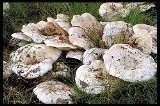
Lactarius controversus
Encyclopedia
Lactarius controversus is a large funnel-capped fungus
within the genus Lactarius
, which are collectively known as 'milk caps'. They all exude milky drops (lactate) from the flesh and gills when damaged. It has no common English name.
surface, often arranged in concentric rings. Like other fungi in the genus, it has crumbly, rather than fibrous, flesh, and when this is broken the fungus exudes a white milky liquid. Mature specimens are funnel-shaped, with decurrent gills and a concave cap
. It has firm, tough flesh, and a stipe
which is shorter than the fruitbody is wide. The spore print
is creamy-pink in colour.
A similar species the Fleecy Milk-cap Lactarius vellereus, lacks the pinkish gills, and 'rosy' cap
markings.
.jpg)
.jpg)
, and Europe
, and usually grows with species of Salix (Goat willow or Creeping willow) on heaths and moors.It is uncommon. It is widespread in North America
growing with aspen
, poplar
, and willow
. Found in the aspen forests of the Sierra Nevada, and has been noted in New Mexico.
Fungus
A fungus is a member of a large group of eukaryotic organisms that includes microorganisms such as yeasts and molds , as well as the more familiar mushrooms. These organisms are classified as a kingdom, Fungi, which is separate from plants, animals, and bacteria...
within the genus Lactarius
Lactarius
Lactarius is a genus of mushroom-producing fungi. The genus, collectively known commonly as milk-caps, are characterized by the fact that they exude a milky fluid if cut or damaged...
, which are collectively known as 'milk caps'. They all exude milky drops (lactate) from the flesh and gills when damaged. It has no common English name.
Description
It is distinguishable mainly by its pinkish-buff gills and rosy markings on the upper capPileus (mycology)
The pileus is the technical name for the cap, or cap-like part, of a basidiocarp or ascocarp that supports a spore-bearing surface, the hymenium. The hymenium may consist of lamellae, tubes, or teeth, on the underside of the pileus...
surface, often arranged in concentric rings. Like other fungi in the genus, it has crumbly, rather than fibrous, flesh, and when this is broken the fungus exudes a white milky liquid. Mature specimens are funnel-shaped, with decurrent gills and a concave cap
Pileus (mycology)
The pileus is the technical name for the cap, or cap-like part, of a basidiocarp or ascocarp that supports a spore-bearing surface, the hymenium. The hymenium may consist of lamellae, tubes, or teeth, on the underside of the pileus...
. It has firm, tough flesh, and a stipe
Stipe (mycology)
thumb|150px|right|Diagram of a [[basidiomycete]] stipe with an [[annulus |annulus]] and [[volva |volva]]In mycology a stipe refers to the stem or stalk-like feature supporting the cap of a mushroom. Like all tissues of the mushroom other than the hymenium, the stipe is composed of sterile hyphal...
which is shorter than the fruitbody is wide. The spore print
Spore print
thumb|300px|right|Making a spore print of the mushroom Volvariella volvacea shown in composite: mushroom cap laid on white and dark paper; cap removed after 24 hours showing pinkish-tan spore print...
is creamy-pink in colour.
A similar species the Fleecy Milk-cap Lactarius vellereus, lacks the pinkish gills, and 'rosy' cap
Pileus (mycology)
The pileus is the technical name for the cap, or cap-like part, of a basidiocarp or ascocarp that supports a spore-bearing surface, the hymenium. The hymenium may consist of lamellae, tubes, or teeth, on the underside of the pileus...
markings.
.jpg)
.jpg)
Distribution and habitat
It is found in BritainGreat Britain
Great Britain or Britain is an island situated to the northwest of Continental Europe. It is the ninth largest island in the world, and the largest European island, as well as the largest of the British Isles...
, and Europe
Europe
Europe is, by convention, one of the world's seven continents. Comprising the westernmost peninsula of Eurasia, Europe is generally 'divided' from Asia to its east by the watershed divides of the Ural and Caucasus Mountains, the Ural River, the Caspian and Black Seas, and the waterways connecting...
, and usually grows with species of Salix (Goat willow or Creeping willow) on heaths and moors.It is uncommon. It is widespread in North America
North America
North America is a continent wholly within the Northern Hemisphere and almost wholly within the Western Hemisphere. It is also considered a northern subcontinent of the Americas...
growing with aspen
Aspen
Populus section Populus, of the Populus genus, includes the aspen trees and the white poplar Populus alba. The five typical aspens are all native to cold regions with cool summers, in the north of the Northern Hemisphere, extending south at high altitudes in the mountains. The White Poplar, by...
, poplar
Poplar
Populus is a genus of 25–35 species of deciduous flowering plants in the family Salicaceae, native to most of the Northern Hemisphere. English names variously applied to different species include poplar , aspen, and cottonwood....
, and willow
Willow
Willows, sallows, and osiers form the genus Salix, around 400 species of deciduous trees and shrubs, found primarily on moist soils in cold and temperate regions of the Northern Hemisphere...
. Found in the aspen forests of the Sierra Nevada, and has been noted in New Mexico.

